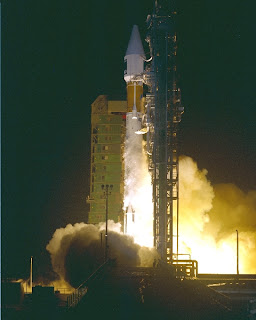SOHO is the Solar Heliospheric Observatory, is a project of international collaboration between the European Space Agency and NASA to study the Sun from its deep core to the outer corona and the solar wind. SOHO was launched on December 2, 1995. The SOHO spacecraft was built in Europe. Together with ESA’s Cluster mission, SOHO is studying the Sun-Earth interaction from different perspectives.
The spacecraft is located in interstellar space part way to the sun (four times the distance of the moon from earth). It stays in a constant position that allows the combined gravity of the Earth and Sun to keep SOHO in an orbit locked to the Earth-Sun line. The mission was originally supposed to conclude in 1997. However, the equipment has continued working so the mission has been extended five times. The spacecraft was still sending images, video, and data, through 2012.
The spacecraft is located in interstellar space part way to the sun (four times the distance of the moon from earth). It stays in a constant position that allows the combined gravity of the Earth and Sun to keep SOHO in an orbit locked to the Earth-Sun line. The mission was originally supposed to conclude in 1997. However, the equipment has continued working so the mission has been extended five times. The spacecraft was still sending images, video, and data, through 2012.
OBJECTIVES
SOHO was designed to answer the following three fundamental scientific questions about the Sun:
--What is the structure and dynamics of the sun?
--Why does the solar corona exist and how is it heated to the extremely high temperature of about 1,000,000°C?
--Where is the solar wind produced and how is it accelerated?
Clues on the solar interior come from studying seismic waves that are produced in the turbulent outer shell of the Sun and which appear as ripples on its surface.
SCIENCE HIGHLIGHTS
Research results have revealed the first images ever of a star's convection zone (its turbulent outer shell) and of the structure of sunspots below the surface.
The mission has provided the most detailed and precise measurements of the temperature structure, the interior rotation, and the gas flows in the solar interior.
SOHO has monitored the total solar irradiance as well as variations in the extreme ultra violet flux of the sun which is important to understand how the sun affects the Earth's weather.
Instruments can now measure and track the acceleration and changes in the speed of solar wind.
Using SOHA equipment scientists can study and identify the source regions and acceleration mechanism of the fast solar winds generated at the poles of the sun.
The mission has discovered new dynamic solar phenomena such as coronal waves and solar tornadoes.
Data from SOHO has revolutionized our ability to forecast space weather. Scientists can now provide up to a three day notice of earth-directed disturbances,which is an early warning system of possibly dangerous space weather.
SOHA has become the most prolific discoverer of comets. As of January 2011, more than 2,000 comets have been found by this mission.












No comments:
Post a Comment